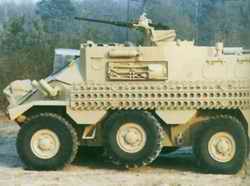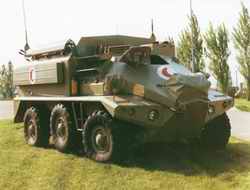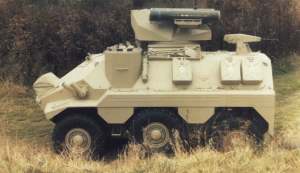| Designation: | VCR |
 |
|---|---|---|
| Manufacturer: | Societe de Constructions Panhard et Levassor | |
| Product type: | Armoured Vehicles | |
| Name: | Wheeled armoured personnel carrier |
The VCR (Véhicule de Combat à Roues) range of 6 × 6 armoured personnel carriers was developed by Panhard as a private venture from 1975 for the export market. The range was first shown in 1977 at the Satory Exhibition of Military Equipment and entered production at Panhard's Marolles factory the following year.
Although the VCR range was developed as a private venture, it has recently been disclosed that it was originally designed specifically for the Iraqi programme to find a platform for the 100 Euromissile UTM-800 four-round HOT anti-tank guided missile turrets ordered in September 1974.
Early in 1975, an international competition was held by Iraq to find a chassis suitable for the Euromissile UTM-800 HOT turret following which the Panhard VCR was selected. The suspension system was taken from the existing Panhard M3 (4 × 4) APC fitted to a new chassis, the front part of which was very similar to the existing Panhard M3. From the VCR family evolved the Panhard ERC (6 × 6) armoured car. This has been built in large numbers for the French Army and export customers and additional details are given in a separate entry. There has been no recent production of the ERC armoured car and it is no longer being marketed.
First production VCR vehicles, equipped with the one-person Euromissile UTM 800 turret, were completed in 1979. The VCR range of armoured personnel carriers uses 95 per cent of the automotive components of the Panhard ERC range of 6 × 6 armoured cars which was also shown for the first time in 1977. Late production Panhard VCR (6 × 6) vehicles had a redesigned hull, a troop compartment roof 400 mm above the commander's position, external stowage boxes, more internal hull space, twin doors at the hull rear and petrol fuel tanks repositioned from inside the troop compartment to under the floor.
In June 1983, Panhard issued new specifications for the VCR range of 6 × 6 APCs. These showed that there had been slight changes to the vehicle with the wheelbase increased from 1.425 + 1.425 m to 1.66 + 1.425 m. This has made the hull slightly longer and increased the overall weight of the vehicle. The specifications for the VCR/TH anti-tank version remain unchanged except for an increase in loaded and empty weights.
By mid-2007, production of the VCR range of 6 × 6 APCs amounted to 262 vehicles, all for export.
As far as is known, there has been no recent production of the VCR series of 6 × 6 vehicle.
Recent information has indicated that Gabon has taken delivery of 10 VCR/TT (6 × 6) armoured personnel carriers. Description
The all-welded steel hull of the VCR/TT (Transport de Troupes) protects the crew against small arms fire and shell splinters. The floor of the hull consists of two plates welded together to form a flat 'V', which helps the vehicle to slide off obstacles and also offers resistance to damage from mines.
The driver sits at the front of the hull in the centre and has a single-piece hatch cover that opens to the right with three integral day periscopes for forward observation, the centre one replaceable by an image intensification periscope for driving at night.
The commander sits to the rear of the driver on the left side at a higher level and has a single-piece hatch cover that opens forwards and seven day periscopes around his position.
The Peugeot engine is to the rear of the driver on the right side and power is transmitted through the single clutch plate to a transversely mounted Panhard gearbox (as fitted to the Panhard AML armoured car and Panhard M3 APC) with six forward and one reverse gears and incorporating a limited slip differential. Drive from the bevel gears to the road wheels is by a train of gears housed within trailing arms, which independently locate the wheels.
The front and rear wheels are sprung by single coil springs with telescopic hydraulic dampers. The centre wheels, which are raised off the ground when on roads, are sprung by hydropneumatic units. The centre wheels are powered even when raised clear of the road surface. All wheels have disc brakes. Only the front wheels are steered, and steering is hydraulically assisted. The low-pressure tyres are fitted with Hutchinson cellular inner tubes, which enable the vehicle to travel for at least 100 km at 30 km/h when the tyres have been punctured.
The 10 infantrymen are seated on bench seats: five along each side of the hull facing each other. They enter and leave the vehicle by a large door in the rear of the hull, which is hinged on the right side and has a single firing port. Two observation/firing hatches in each side of the troop compartment open upwards and can be locked open. The VCR/TTs built for the United Arab Emirates have a wider hull with double doors at the rear to give increased leg room.
The armament is mounted to the rear of the commander's position in the roof. When armed with a 7.62 mm machine gun the VCR/TT can carry nine men plus its crew of three (commander, driver and gunner, who sits on one of the bench seats when not manning the machine gun) but when heavy armament is installed, such as a 20 mm cannon, only six infantrymen can be carried plus a crew of three. The VCR/TT can be fitted with a variety of armament installations including: a TRW BTM 263 turret with a 60 mm mortar and a 7.62 mm machine gun; a Nexter Systems (previously Giat Industries) STB ring mount with a shield (which forms the hatch cover when not in use) and a 7.62 mm machine gun; a Nexter Systems CB rotating gun ring with a 7.62 mm machine gun; a Nexter Systems turret with twin 7.62 mm machine guns; a Nexter Systems gun ring Model CB 20 with a 20 mm cannon; a Nexter Systems gun ring with a TDA 60 mm breech-loaded mortar; a Nexter Systems one-man turret armed with a 20 mm cannon; and a 7.62 mm machine gun. There is also a single-piece hatch cover in the roof of the troop compartment at the rear, which opens towards the front. A 7.62 mm machine gun on a Nexter Systems STR rail mount can be mounted behind it. Two electrically operated grenade dischargers can be mounted on either side of the hull if required.
The VCR is fully amphibious being propelled in the water by its wheels and steered by turning the front road wheels as for land operations. Optional equipment includes a front-mounted winch with 60 m of cable and a capacity of 3,000 kg, NBC system, air conditioning system and passive night vision equipment. Variants
The VCR/AT (Atelier Véhicule) is the basic vehicle modified to undertake repairs in the field. It has no recovery capability although it can tow other vehicles.
Equipment installed includes a generator, tools, workbenches, an inspection lamp, towbars and tow cables. A penthouse can be erected at the rear to enable repairs to be carried out in bad weather. A block and tackle can be erected at the rear allowing the VCR/AT to carry out engine and other component changes. This model is used by Argentina and the United Arab Emirates.
This was unveiled in 1984 and is fitted with the now SAAB Bofors Dynamics RBS 70 surface-to-air missile system. The VCR/AA weighs 7,500 kg and has a crew of three. Mounted in the rear troop compartment is the RBS 70 missile launcher with one missile ready to launch and a further eight in reserve. This model has yet to enter production.
This is the basic VCR/TT fitted with the Euromissile UTM 800 HOT turret mounted on a raised plinth to the rear of the commander's position. The turret has four ready to launch 4,000 m range HOT missiles and another 10 missiles carried in reserve in the hull are loaded via a hatch in the right rear of the roof, which opens to the right. The turret has an optical sight with a magnification of ×3 (18° field of view) and ×12 (5° field of view), elevation being +22°, depression -10° and turret traverse 360°.
Mounted on the roof at the rear on the left is a Nexter Systems Mascot remote-controlled 7.62 mm machine gun which can be elevated from -10 to +50° and traversed through a full 360°. There are 200 rounds of ready use ammunition provided for this weapon. Two grenade dischargers are mounted on the front of the hull at either side. Panhard has delivered 100 of these vehicles to Iraq. Following the 2003 Middle East conflict it is assumed that none of these systems are operational and the HOT missiles have now expired their shelf-life.
The VCR/IS (Véhicule Blindé d'Intervention Sanitaire) is the ambulance member of the family and has a much higher hull behind the commander than the basic VCR. The vehicle has a crew of three (commander, driver and orderly) and can carry four stretcher patients or six sitting and two stretcher patients.
The casualties enter the vehicle through a door at the rear of the hull that opens to the left and has a single vision port. Unlike the basic APC, there are no observation flaps in the sides of the hull.
Equipment carried includes folding stretchers, cupboards and instrument storage lockers, a water tank, a refrigerator and breathing and blood transfusion equipment. If required, a tent, which is stowed in boxes on either side of the hull, can be erected at the rear. This model is used by the United Arab Emirates.
This is basically the VCR/TT adapted for use as a command vehicle with map boards, tables and additional communications equipment. This model is used by Argentina and the United Arab Emirates.
This was developed to meet the requirements of the Argentine Marines and is essentially the 6 × 6 VCR/TT with the central roadwheel either side removed and a waterjet installed in its place.
This gives the VCR/TT a maximum water speed of 7.2 km/h. Before entering the water, the bilge pumps are switched on and a trim vane with transparent upper part for forward observation is erected at the front of the vehicle.
Panhard General Defense have developed an upgrade package for their Sagaie (6 × 6) armoured car. This is also applicable to the Panhard General Defense VCR (6 × 6) APC.
This never entered production and is no longer being marketed.
This was a project only and is no longer being marketed.
|
||||||||||||||||||||||||||||||||||||||||||||
|
|||||||||
|
|||||||||||||||||||||
 |
 |
 |
 |
 |
 |




